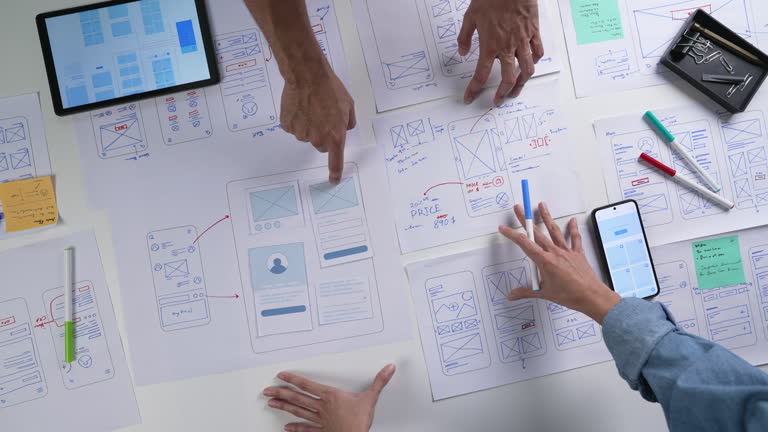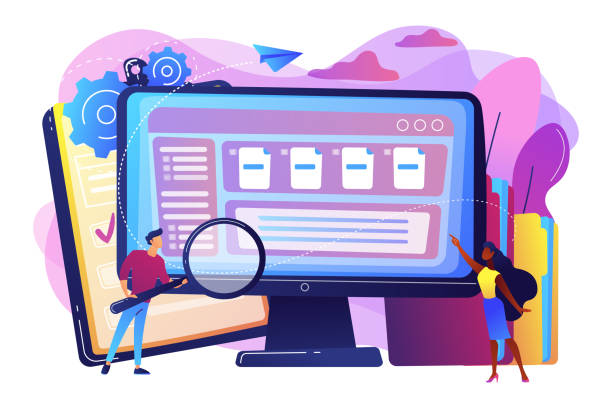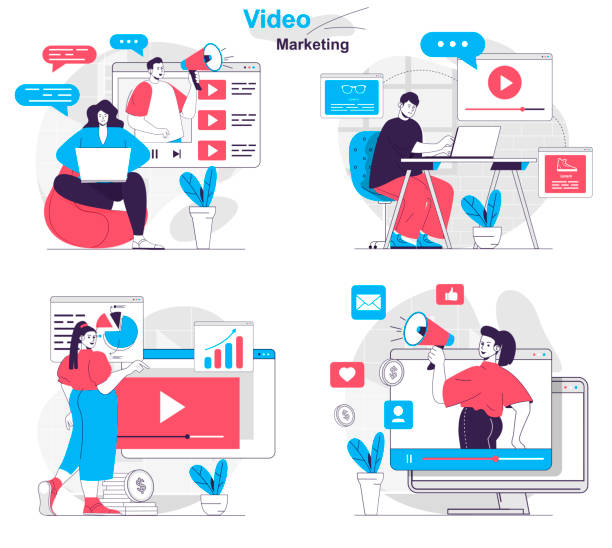The Importance of Fast Website Design for Businesses

In today’s fast-paced digital world, where every second is vitally important, #website loading speed is not just a competitive advantage, but has become a necessity.
Internet users have little patience, and if your website loads slowly, they will quickly leave it and go to your competitors.
This phenomenon is known as #bounce rate and can have a devastating effect on your business.
According to numerous studies, even a one-second delay in page load time can reduce the conversion rate by up to 7%.
This is where the importance of fast website design for any online business becomes apparent.
Google, as the largest search engine, also places special emphasis on #user experience and website speed.
Loading speed is one of the key factors in the SEO (Search Engine Optimization) ranking algorithm.
Slower websites get lower rankings in search results, which means less visibility and lower organic traffic.
In contrast, a website with fast website design can attract more traffic, gain #user trust, and ultimately lead to increased sales and revenue.
It’s a simple truth: speed equals profit.
In the following sections, we will delve into more details about how to achieve this speed in an #explanatory and #analytical manner.
Choosing a fast website design strategy is not just a technical measure, but a strategic decision for survival and growth in today’s competitive market.
Are you tired of your e-commerce site having visitors but no sales? Rasaweb solves your main problem with professional e-commerce website design!
✅ Significant sales increase with targeted design
✅ Flawless user experience for your customers
⚡ Get a free consultation!
Key Factors Affecting Website Speed

To achieve a #fast website, it is essential to understand the main factors that affect loading speed.
These factors include various aspects from #coding to site content and its hosting infrastructure.
One of the most important factors is the overall page data size.
The larger the size of CSS, JavaScript, image, and font files, the longer the loading time will be.
Optimized coding and clean code, without extra or repetitive code, play a significant role in reducing this size and increasing speed.
Another point is the optimization of #images and other media.
High-quality and large-sized images can severely reduce loading speed.
Using appropriate formats, compression, and Lazy Loading of images are vital solutions for fast website design.
Also, the number and quality of #plugins and external scripts used on the website should be considered.
Each extra plugin or script can lead to performance overhead and reduce speed.
Website Hosting is also a determining factor.
Choosing a reliable and high-quality hosting service that offers high-speed servers and sufficient bandwidth is crucial for any fast website design project.
Servers closer to target audiences and using new technologies like HTTP/2 and HTTP/3 can significantly reduce server response time.
This is a #specialized issue that requires careful consideration.
Additionally, database optimization, using caching systems, and minifying CSS and JS files are other actions that should be considered for fast website design.
Website Speed Optimization Tools and Techniques

To achieve maximum website speed, it is essential to use a set of tools and techniques.
This section provides #guidance and #educational information on some of the most important ones.
The first step in #speed optimization is to use speed analysis tools such as Google PageSpeed Insights, GTmetrix, or Pingdom Tools.
These tools identify your website’s weaknesses and offer suggestions for improvement.
One of the widely used techniques is Caching.
Caching helps the browser store a version of your website’s content so that on subsequent visits, there’s no need to re-download all files.
This significantly reduces loading time for returning users.
Also, file compression using Gzip or Brotli reduces the size of HTML, CSS, and JavaScript files before sending them to the browser.
This action also helps reduce data transfer time and increase speed.
Minification of code means removing white spaces, comments, and extra characters from CSS and JavaScript files, which reduces their size without affecting performance.
Eliminate render-blocking resources is also a technique that ensures critical CSS and JavaScript files that are not essential for the initial page render are loaded after the main content.
This technique helps improve First Contentful Paint (FCP).
All these actions are of great importance in the path of fast website design.
In the table below, we compare some of these methods:
| Optimization Method | Description | Impact on Speed |
|---|---|---|
| Browser Caching | Stores a copy of content on the user’s device for subsequent visits. | Very High for returning users. |
| Gzip/Brotli Compression | Reduces file size before sending to the browser. | High in data transfer time. |
| Code Minification | Removes extra characters from CSS and JS. | Medium by reducing file sizes. |
| Image Lazy Loading | Loads images only when the user scrolls to that part of the page. | Very High in initial page load time. |
| Using CDN | Distributes content across servers closer to the user. | Very High by reducing network latency. |
The Role of Hosting and Server in Fast Website Design

Choosing the right hosting service is perhaps one of the most important decisions you should make in the fast website design process.
Many people pay less attention to this aspect, while server infrastructure and hosting can directly affect your server response time (Time To First Byte – TTFB) and ultimately your overall website speed.
An unsuitable hosting service can reduce your site’s speed even with the best coding and optimizations.
There are different types of hosting, each with its own features and advantages.
#Shared_Hosting is the cheapest option, but server resources are divided among multiple websites, which can lead to slower speeds during peak traffic.
For growing businesses or high-traffic websites, using #Dedicated_Servers or #VPS (Virtual Private Server) is recommended, which allocate more resources to your website.
Cloud Hosting is also a flexible and scalable option that can adapt to your changing traffic needs and provide higher stability and speed.
In addition to the type of hosting, the server physical location is also important.
The closer the server is to your target audience, the lower the network latency and thus the higher the loading speed.
Also, #bandwidth and the speed of server hard drives (SSD vs. HDD) are important factors.
A hosting with a #strong_infrastructure and up-to-date technology that supports new technologies like HTTP/2 and HTTP/3 can guarantee a fast website design and optimal performance.
Before making a final choice, thorough research and comparison of different providers are essential to find the best option for your specific needs.
Are your e-commerce site visitors leaving before buying? Worry no more! With Rasaweb’s professional e-commerce website design services, solve the problem of not converting visitors into customers forever!
✅ Significant increase in conversion rate and sales
✅ Unique and engaging user experience
⚡ Contact us now for a free consultation!
Content Delivery Networks (CDN) and Their Impact
![]()
One of the most powerful tools in enhancing website speed, especially for audiences scattered across the globe, is the use of Content Delivery Networks or CDN.
This section provides an #analytical review of this technology and its impact on fast website design.
CDNs are a collection of servers distributed across various geographical locations worldwide.
Their primary function is to deliver your website’s content (such as images, CSS, JavaScript, videos, and other static files) from the server closest to the user.
Imagine your website is hosted on a server in Europe, and a user from Australia wants to visit it.
Without a CDN, all requests from this user would have to travel to the main server in Europe, and the content would then be sent back to Australia.
This long journey causes #network_latency and consequently reduces loading speed.
But with a CDN, when a user from Australia requests content, the CDN delivers the content to them from its nearest server in Asia or Oceania.
This significantly reduces #response_time and improves #user_experience.
CDNs also help reduce the load on your main server, as static content requests are answered by CDN servers instead of the main server.
This allows your main server to handle dynamic website requests more efficiently.
Furthermore, many CDNs also offer features such as automatic compression, image optimization, and protection against DDoS attacks, which double your website’s security and performance.
Choosing a suitable CDN is a fundamental step in ensuring a fast website design and providing an unparalleled experience for your users anywhere in the world.
Optimizing Images and Multimedia

Images and other multimedia, if not properly optimized, can become one of the biggest obstacles to fast website design.
In this section, we will discuss the key aspects of #image_optimization in an #educational and #guidance manner.
High-volume images, especially on landing pages and blog posts, can significantly increase loading time and disrupt the user experience.
The first step is choosing the right image format.
Formats like JPEG are suitable for photos (which have many color details) and PNG for images with transparency or logos.
But today, next-generation formats like #WebP are highly recommended due to their higher compression ratio and similar image quality.
WebP can reduce image size by 25-35% compared to JPEG and PNG, which has a significant impact on loading speed.
The next step is #image_compression.
There are many online tools and WordPress plugins that help you compress images without significant quality loss.
Also, ensure that images are uploaded with appropriate dimensions.
There’s no need to place a 3000-pixel image in a space that is only 500 pixels wide.
Resizing images before uploading them significantly reduces file size.
Using the #lazy_loading technique for images is also very important.
With this method, images are loaded only when the user scrolls to the relevant section on the page, not during the initial page load.
This significantly improves initial speed, especially on pages with many images, and is a crucial step in fast website design.
Also, optimizing videos by using streaming services like YouTube or Vimeo instead of hosting them directly on your server is recommended due to high bandwidth consumption.
Mobile-First Approach and Responsiveness for Speed
![]()
With the increasing number of internet users accessing via mobile devices, the #Mobile-First_approach is not just a design trend but a crucial strategy for fast website design and success in the digital age.
Google also prioritizes the mobile version when ranking sites.
This section provides a #specialized and #guidance review of this approach and related techniques.
#Responsive_Design ensures that your website automatically adapts to the user’s screen dimensions, whether desktop, tablet, or mobile.
However, #Mobile_First means that the design and development process begins for small mobile screens first and then scales up to desktop.
This approach helps designers and developers focus on essential content and optimal performance, which naturally leads to a lighter and faster site.
Other technologies such as #AMP (Accelerated Mobile Pages) and #PWA (Progressive Web Apps) are also designed to increase speed and user experience on mobile.
AMP optimizes web pages for instant loading on mobile devices, while PWAs offer an app-like user experience through the browser, including offline access and push notifications.
Using these technologies can significantly contribute to achieving a fast website design that is responsive on mobile.
In the table below, we examine the key features of responsive design and their impact on speed:
| Responsive Design Feature | Description | Speed and Efficiency Benefit |
|---|---|---|
| Image compression for different devices | Providing lower-volume versions of images for mobile displays. | Reduced loading time for images on mobile. |
| Fluid Grid Layout | Using percentages and relative units instead of fixed pixels. | #Flexibility and preventing unnecessary horizontal scrolling. |
| Media Queries | Applying specific CSS styles based on screen dimensions. | #Loading_appropriate_content for each device and display optimization. |
| Optimized Menus for Mobile | Using hamburger or dropdown menus. | Better user experience and preventing interface clutter. |
| Compatible Fonts and Typography | Adjusting font size and type for readability on small screens. | Improved readability and eliminating the need for zooming. |
User Experience and Bounce Rate: A Direct Relationship with Speed

Have you ever wondered why some websites, despite having excellent products or services, fail to attract and retain customers? The answer often lies in one word: #speed.
This section provides a #thought-provoking_content and #analytical review of the vital connection between fast website design, #user experience (UX), and #bounce rate.
Did you know that 53% of mobile visitors abandon a site if it takes more than 3 seconds to load? This statistic alone is enough to realize how much speed can influence user decisions.
When a website is slow, users feel frustrated, impatient, and even distrustful.
This unpleasant feeling causes them to leave the website and not return.
This is where the #bounce_rate increases; meaning a high percentage of visitors leave your website after only viewing one page.
A high bounce rate not only indicates a poor user experience but also sends a negative signal to search engines, which can harm your SEO ranking.
In contrast, a website with fast website design increases #user satisfaction.
Users can quickly access the information they need, navigate pages without delay, and complete the purchase or registration process without problems.
This positive experience leads to increased #trust and ultimately a higher #conversion_rate.
In fact, investing in fast website design is an investment in increasing sales and customer loyalty.
Are you ready to attract more customers and provide a seamless user experience by improving your site’s speed? This is the fundamental question every business owner should ask themselves.
Does your current e-commerce website design not bring you the expected sales?
Rasaweb specializes in professional e-commerce website design!
✅ An attractive and user-friendly site aimed at increasing sales
✅ High speed and security for an ideal shopping experience⚡ Get a free online store design consultation with Rasaweb now!
Future Trends in Web Speed Optimization

The web world is constantly evolving, and speed optimization is no exception.
To stay competitive and provide the best user experience, it is essential to be familiar with #future_trends in fast website design.
This section provides a #news-related and #entertaining overview of some of these leading trends.
One of the most important developments is the advancement in network protocols.
#HTTP/3, as the successor to HTTP/2, is built on the UDP protocol and promises reduced latency and improved performance, especially in unstable and mobile networks.
This protocol will provide a faster and smoother loading experience for users.
Google’s Core Web Vitals will also continue to be a golden standard for measuring user experience and site speed.
Websites must continuously monitor and improve these metrics to achieve better search rankings.
#Artificial_intelligence and #machine_learning tools are also expected to play an increasing role in automatic website optimization.
These tools can analyze traffic patterns, optimize resources, and even adjust content based on user behavior to ensure maximum speed.
#WebAssembly technology also allows developers to execute high-performance code directly in the browser, which can mean more complex web applications with near-native performance.
This has great potential for improving the speed of heavy web applications.
Also, focusing on #semantic_code_optimization and using lighter and more efficient frameworks in the fast website design process will be another important future trend.
These developments show that speed is not just a goal, but a continuous path for innovation and progress in the web world.
Conclusion and Practical Steps for Fast Website Design

Throughout this article, we have covered various aspects of the importance of fast website design, factors affecting it, and techniques to achieve it.
From its impact on #SEO and #user experience to the role of hosting, CDN, and media optimization.
Now, it’s time to #educational and #explanatory summarize all these learnings and provide practical steps for implementing a high-speed website.
The first practical step is to analyze and evaluate the current status of your website.
Use the introduced tools like Google PageSpeed Insights to identify weaknesses.
Then, develop a #comprehensive_planning to improve these weaknesses.
This plan should include image optimization, code minification, caching activation, and, if necessary, upgrading your hosting service.
The second step is the gradual implementation of changes and continuous monitoring of results.
After each change you apply, re-evaluate its results with speed analysis tools.
This #continuous_monitoring helps you measure the real impact of your actions and continue optimizations.
Remember that fast website design is not a one-time process, but a continuous effort to maintain optimal performance.
Finally, if you do not have sufficient technical knowledge to perform these optimizations, seek #expert_consultation with fast website design and web development specialists.
A professional team can provide the best strategies based on your business’s specific needs and ensure that your website operates at its peak efficiency.
By implementing these steps, you will not only increase your website’s speed but also improve #customer_satisfaction and ultimately contribute significantly to the growth and success of your business in the competitive online space.
The future of the web belongs to fast websites; so act today!
Frequently Asked Questions
| No. | Question | Answer |
|---|---|---|
| 1 | What does fast website design mean? | Optimizing a website for fast page loading, improved user experience, and SEO ranking. |
| 2 | Why is website loading speed important? | Increased user satisfaction, reduced bounce rate, improved SEO, and increased conversion rate (sales/actions). |
| 3 | What tools are available to test website speed? | Google PageSpeed Insights, GTmetrix, Pingdom Tools are common tools. |
| 4 | What are the main factors slowing down a website? | Unoptimized images, heavy JavaScript and CSS codes, poor hosting, and lack of caching. |
| 5 | “Caching” what is it and how does it help website speed? | Temporarily storing site data in the user’s browser or server for faster loading on subsequent visits. |
| 6 | How to optimize images to increase website speed? | Reducing image size (compression) without significant quality loss, using modern formats (WebP), and setting appropriate dimensions. |
| 7 | What role does CDN (Content Delivery Network) play in fast website design? | Distributing website content across various servers worldwide to deliver content from the closest server to the user. |
| 8 | Does choosing appropriate hosting affect website speed? | Yes, quality hosting and powerful servers are essential for fast website loading. |
| 9 | What is Minification technique and why is it used? | Removing extra characters (white spaces, comments) from HTML, CSS, JavaScript codes to reduce file size. |
| 10 | What is the relationship between responsive design and website speed? | Responsive design means proper display on different devices; if not implemented correctly, it can create extra load and reduce speed. Responsive optimization is important for speed. |
And other advertising agency services by Rasaweb in the field of advertising
Smart SEO: An effective tool for campaign management with the help of Google Ads management.
Smart Conversion Rate Optimization: An innovative platform for improving click-through rate increase using real data.
Smart SEO: Designed for businesses looking to increase click-through rates through marketing automation.
Smart Marketing Automation: Designed for businesses looking for user engagement through intelligent data analysis.
Smart Data Analysis: A professional solution for digital branding focusing on intelligent data analysis.
And over hundreds of other services in the field of internet advertising, advertising consulting, and organizational solutions
Internet Advertising | Advertising Strategy | Advertorial
Sources
10 Tips for Fast and Efficient Website Design
Comprehensive Guide to Digital Marketing for Businesses
Why is a Website Crucial for Your Business Success?
Latest Website Design Trends in 2024
✅? Are you ready to transform your business in the digital world? Rasaweb Afarin Digital Marketing Agency, by providing comprehensive solutions for SEO, content marketing, and personal website design, is your strategic partner in achieving sustainable success.
📍 Tehran, Mirdamad Street, next to Bank Markazi, Kazeroon South Alley, Ramin Alley, No. 6


